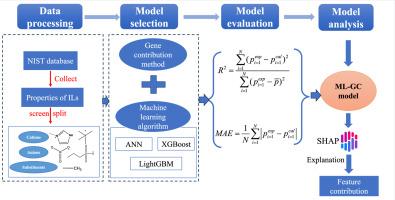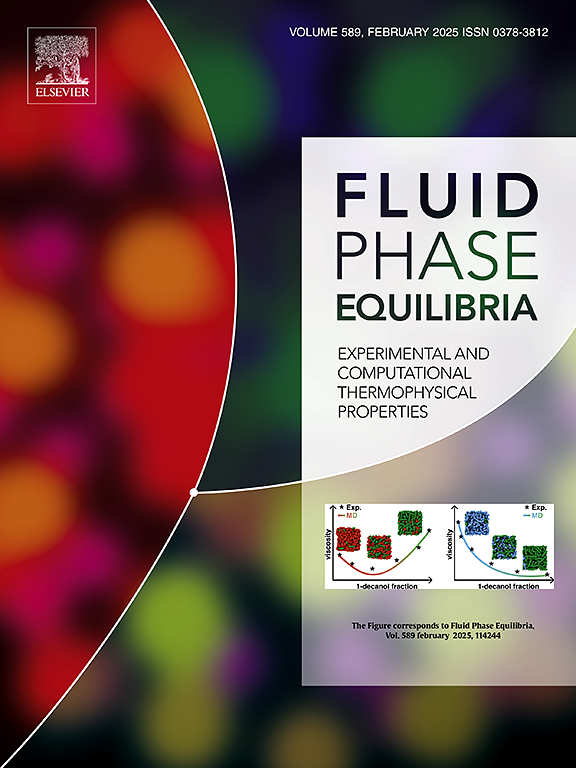离子液体-离子液体-水三元混合物密度和粘度的模拟研究
IF 2.7
3区 工程技术
Q3 CHEMISTRY, PHYSICAL
引用次数: 0
摘要
离子液体(ILs)的巨大多样性需要开发准确的预测模型来支持其工业应用。本研究将机器学习(ML)算法与群贡献(GC)方法相结合,对IL-IL-H2O三元混合物的密度和粘度进行了建模。采用三种机器学习算法(即ANN、XGBoost和LightGBM)开发鲁棒预测模型,并在大型实验数据集上进行训练。分析了数据集划分对预测结果的影响,并通过5次交叉验证验证了模型的泛化性。ANN-GC模型对密度和粘度均有较好的预测效果,密度的平均绝对误差(MAE)为1.7909,相关系数(R2)为0.9933,粘度的平均绝对误差(MAE)为0.0329,相关系数(R²)为0.9813。采用贝叶斯优化方法对人工神经网络模型进行超参数优化,采用网格搜索方法对XGBoost和LightGBM模型进行优化。优化后,3种模型的预测精度均有提高,ANN-GC保持最高的预测精度。其中,优化后的ANN-GC模型预测密度的MAE为1.5834,R2为0.9963;预测粘度的MAE为0.0279,R2为0.9924。通过SHapley加性解释(SHapley Additive exPlanations)分析获得了进一步的见解,该分析澄清了不同特征对模型预测的贡献。通过对流体流动单元过程实例的计算,验证了密度和粘度预测模型的有效性。本文章由计算机程序翻译,如有差异,请以英文原文为准。

Modeling study on the density and viscosity of ionic liquid-ionic liquid-water ternary mixtures
The vast diversity of ionic liquids (ILs) necessitates the development of accurate predictive models to support their industrial applications. This study combines machine learning (ML) algorithms with group contribution (GC) methods to model the density and viscosity of IL-IL-H2O ternary mixtures. Three ML algorithms (i.e., ANN, XGBoost, and LightGBM) were employed to develop robust predictive models, which were trained on a large experimental dataset. The effect of dataset partitioning on the prediction results is analyzed, and the generalizability of the models is validated through 5-fold cross-validation. The ANN-GC model performs well in predicting both density and viscosity properties, with a mean absolute error (MAE) of 1.7909 and a correlation coefficient (R2) of 0.9933 for density, and an MAE of 0.0329 and an R² of 0.9813 for viscosity. Furthermore, hyperparameters for the ANN model were optimized using Bayesian optimization, while XGBoost and LightGBM were optimized via grid search. After optimization, the prediction accuracies of all three models improved, with ANN-GC maintaining the highest prediction accuracy. Specifically, the optimized ANN-GC model achieves an MAE of 1.5834 and an R2 of 0.9963 for density prediction, and an MAE of 0.0279 and an R2 of 0.9924 for viscosity prediction. Further insights were obtained through SHAP (SHapley Additive exPlanations) analysis, which clarified the contributions of different features to the model predictions. Additionally, the validity of the density and viscosity prediction models was confirmed by calculating the fluid flow unit process case.
求助全文
通过发布文献求助,成功后即可免费获取论文全文。
去求助
来源期刊

Fluid Phase Equilibria
工程技术-工程:化工
CiteScore
5.30
自引率
15.40%
发文量
223
审稿时长
53 days
期刊介绍:
Fluid Phase Equilibria publishes high-quality papers dealing with experimental, theoretical, and applied research related to equilibrium and transport properties of fluids, solids, and interfaces. Subjects of interest include physical/phase and chemical equilibria; equilibrium and nonequilibrium thermophysical properties; fundamental thermodynamic relations; and stability. The systems central to the journal include pure substances and mixtures of organic and inorganic materials, including polymers, biochemicals, and surfactants with sufficient characterization of composition and purity for the results to be reproduced. Alloys are of interest only when thermodynamic studies are included, purely material studies will not be considered. In all cases, authors are expected to provide physical or chemical interpretations of the results.
Experimental research can include measurements under all conditions of temperature, pressure, and composition, including critical and supercritical. Measurements are to be associated with systems and conditions of fundamental or applied interest, and may not be only a collection of routine data, such as physical property or solubility measurements at limited pressures and temperatures close to ambient, or surfactant studies focussed strictly on micellisation or micelle structure. Papers reporting common data must be accompanied by new physical insights and/or contemporary or new theory or techniques.
 求助内容:
求助内容: 应助结果提醒方式:
应助结果提醒方式:


